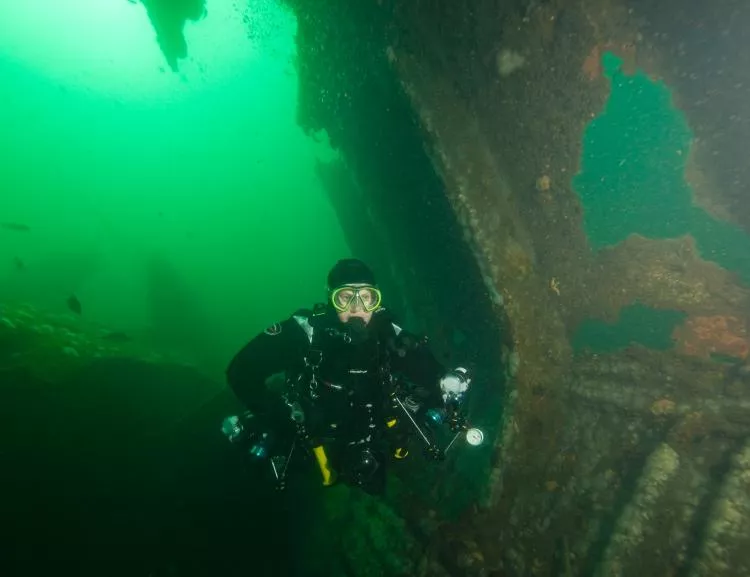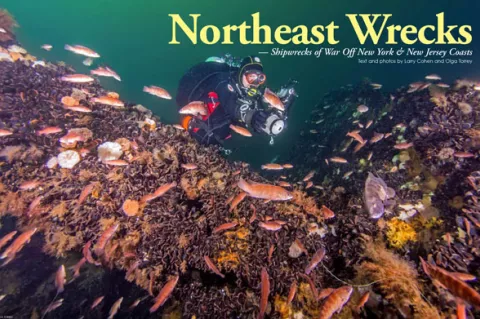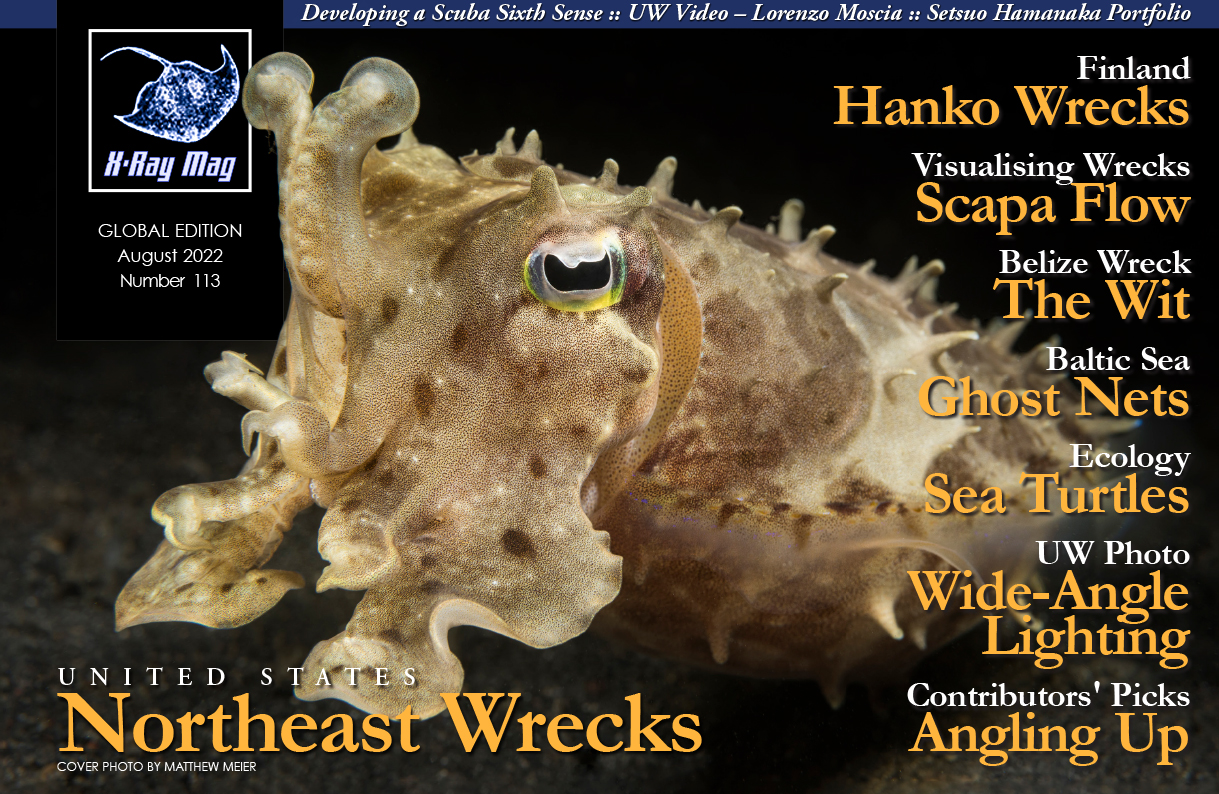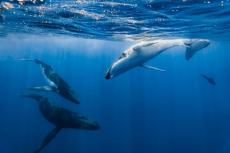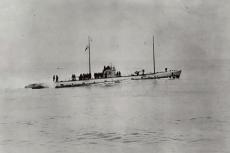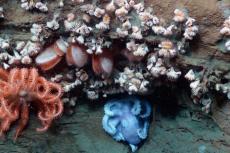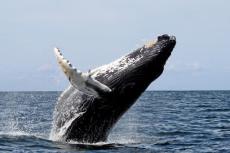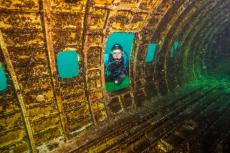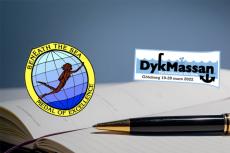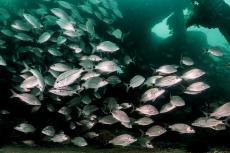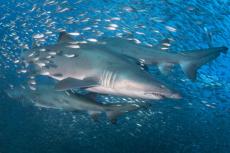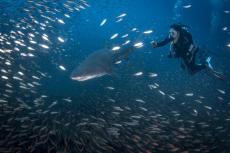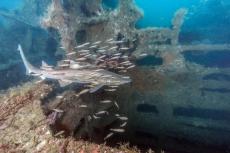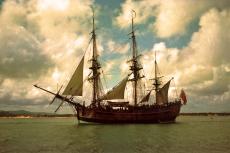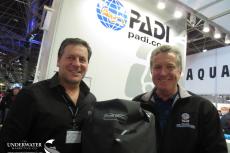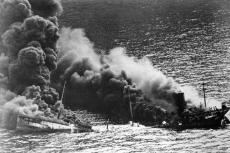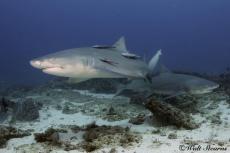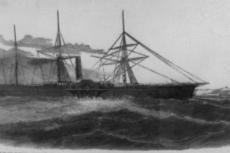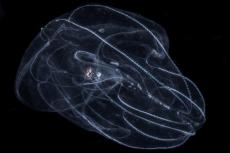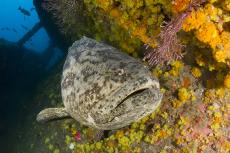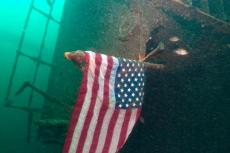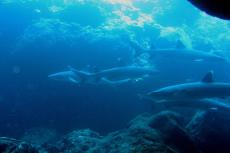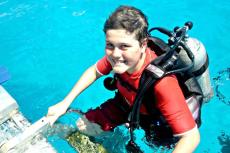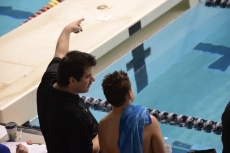The waters running north to south from the Long Island coast to northern New Jersey are nicknamed “Wreck Valley” by local divers. Larry Cohen and Olga Torrey share the stories of some of the war shipwrecks found in these waters, located off the US northeastern coast.
Contributed by
Due to navigation errors, lousy weather and war, there are hundreds of shipwrecks in the waters of New York and New Jersey. These are unfortunate marine disasters, but they do provide habitat for marine life. As a matter of fact, both New York and New Jersey have an artificial reef program, where they sink ships on purpose. Many of these wrecks are at depths of 24 to 45m (80 to 150ft).
Some hardy people dive all year round, but most diving is done between April and November. The water temperatures are between 13 to 5°C (55 to 40°F). It is possible to dive in a 7mm wetsuit, but to be comfortable, you will need a drysuit.
Most boats require single-tank divers to carry a pony bottle, but most experienced local divers use doubles or rebreathers. Diving Wreck Valley is not for the casual diver, but to experience the history, mystery and local marine life, it is worth the effort. Let’s explore a few of the area’s most famous wrecks sunk in war.
USS San Diego
During history lessons in grade school, my teachers never talked about how close WWI and WWII came to US shores. We learned all about the war in Europe and the Pacific, but we were never informed about German U-boats right off the US coast.
The USS San Diego was a heavy-armored cruiser built in 1907. On 19 July 1918, when traveling off the coast of Long Island, New York, it reportedly hit a mine laid by the German submarine U-156. The ship sank in 28 minutes, and six sailors out of a crew of 1,183 men lost their lives.
The San Diego is the only major warship the United States lost during WWI, and she sits only 12.87km (8 miles) from the US coast. This large 153m-long, 21m-wide (503ft-long, 70ft-wide) ship turned turtle and sits upside down in 33.5m (110ft) of water. The keel comes up to 19.8m (65ft). Most dive boats tie into the keel.
In recent years, the ship has deteriorated but is still easy to navigate. The superstructure is under the ship’s hull, but you can still see the large guns peeking out of the wreck. There are many openings for trained divers to penetrate and explore the wreck’s interior.
The large shells can still be seen inside, along with other artifacts. Divers used to recover artifacts, but this is no longer legal.
R.P. Resor
German submariners called January to August 1942 the “Happy Time.” This is because the U-boats off the eastern coast of the United States were very successful in sinking merchant ships. It was designated Operation Paukenschlag (“Operation Drumbeat”) by Admiral Karl Dönitz, the U-boat commander who implemented it. From January to March 1942, U-boats sank scores of ships off the US coast.
The R.P. Resor was one of these causalities sunk on 28 February 1942. The 132.5m-long, 20m-wide (435ft-long, 66ft-wide) tanker was owned by Standard Oil Company, now Exxon Corp. The U-578 fired two torpedoes at the ship. This ruptured the Resor’s oil tanks, setting her on fire, along with the oil-covered waters around the ship. Only two of the 49 crew members survived. The ship burned for two days before sinking in 39.6m (130ft) of water.
The wreck is about 58km (36 miles) off the coast and is a long boat ride away. Most of the wreckage is low-lying and scattered along the bottom. Her stern is intact and rests at an angle. You can still see the deck gun on the stern. Midship, the boilers do have some relief. It is possible to swim inside the boilers where you can find giant lobsters.
Texas Tower 4
Not all wrecks off the northeastern coast are ships. The Texas Tower 4 was a radar tower 136.7km (85 miles) in the middle of the ocean. This structure is underwater because of a “nor’easter” (storm), but the reason it was there in the first place and why 28 men died was the Cold War.
The Texas Tower 4 got its name because it looked like an oil rig, like the ones in the Gulf of Mexico, off Texas. The three rubber domes contained radar equipment. This extended the United States’ monitoring range to almost 241km (150 miles) outwards into the ocean. This was necessary in case the Soviet Union attacked the country.
The problem was that the tower was poorly designed. Its legs penetrated only 4.5m (15ft) into the sand, and the tower had walls that were less than an inch thick. (This earned it the nickname “Old Shaky.”) However, the legs were not strong enough to support a large structure 18.28m (60ft) above 60m (200ft) of water.
In August 1960, Hurricane Donna damaged the tower. Because of all the top-secret gear, the crew was not evacuated. Crew member Don Slutzky said, “The tower shuddered, and we all ran to grab our life vests.” In January 1961, the Air Force decided to shut down the Texas Tower 4’s operation, but they did not do it fast enough.
On 15 January 1961, another storm was predicted to hit the area with 30m (100ft) seas. The navy supply ship AKL-17 was sent to bring the crew safely to shore. While the AKL-17 was en route at 7:28 p.m. on January 16, the radar blip that was the Texas Tower 4 disappeared from the ship’s radar screen. All 28 men, comprising airmen and civilians, perished under the sea with the tower.
Sitting at 60m (200ft) of depth for many years, the wreckage started at depths as shallow as 19.8m (65ft), propped up by its one remaining leg. Then, over the winter of 1999, the leg collapsed. So, the wreck now begins at 36.5m (120ft) with all the interesting structures below 42.6m (140ft).
The Texas Tower 4 is close to the edge of the continental shelf and the Gulf Stream. For this reason, visibility is usually excellent, and the water is blue. The wreck is also visited by fascinating marine life.
U-869 (The U-Who)
Not all German U-boats were successful. For example, the U-869 never sank an Allied ship. The dive boat Seeker, run by Captain Bill Nagle, was checking locations where fishing boats were losing nets when the crew discovered the wreck on 2 September 1991. This was a mystery since Germany had no record of a submarine being sunk at that location, and the United States had no record of sinking a U-boat. This unknown submarine that should not have been there was nicknamed the “U-Who.”
The wreck is 96km (60 miles) off the coast and is in over 60m (200ft) of water. On their third trip to the wreck, Captain John Chatterton and wreck divers Richie Kohler, Steve Gatto and Tom Packer found artifacts that proved the submarine was a German U-boat.
A few dives later, Chatterton found a knife with a wooden handle. The name “Horenburg” was carved into the handle. In December 1993, he sent the sketches and photographs to the Naval Historical Branch of the Ministry of Defence, London, England. The British sent the material to Berlin, Germany, to be assessed by Dr Axel Niestle, an authority on U-boats.
Dr Niestle reported that the “U-Who” was, more than likely, the U-869. The knife was the most important clue. Martin Horenburg, whose last name was on the knife handle, was the only U-boat sailor, and he was on the U-869.
On another dive, Chatterton, Kohler, Dan Crowell, John Yurga, Will McBeth, Pete Wohlleben, and other divers were filming a special for NOVA. On this dive, a spare-parts box marked with a plastic tag was recovered from the starboard side of the electric motor room. The tag was clearly marked U-869.
Now that the wreck’s identity had been confirmed, the question remains: How did it sink off the New Jersey coast? The theory is the U-869 never received its orders to go to Gibraltar, so it headed to its original assignment off the US northeastern coast. At first, it was believed that one of the submarine’s torpedoes malfunctioned, did a circular run, and sank the submarine. However, such self-kills are rare. It is also possible that a US Coast Guard convoy escort sank the sub on 11 February 1945. Since there was no confirmation of the sinking of a submarine, the US Navy denied the Coast Guard’s claim that they had sunk a U-boat.
The boat ride offshore to the U-869 takes a long time. Usually, this is a dark dive, but visibility is good. Most of the wreck is in one piece, but the plating is falling off. The conning tower is lying next to the main wreckage, and it is easy to swim into the conning tower. Besides being a tight squeeze, many cables and other hazards could cause a diver to get entangled.
This is just a tiny sample of the wrecks off New York and New Jersey sunk because of war. In our next article, we will explore wrecks sunk by collision or bad weather.
SOURCES: njmaritimemuseum.org, njscuba.net, Wikipedia.org

